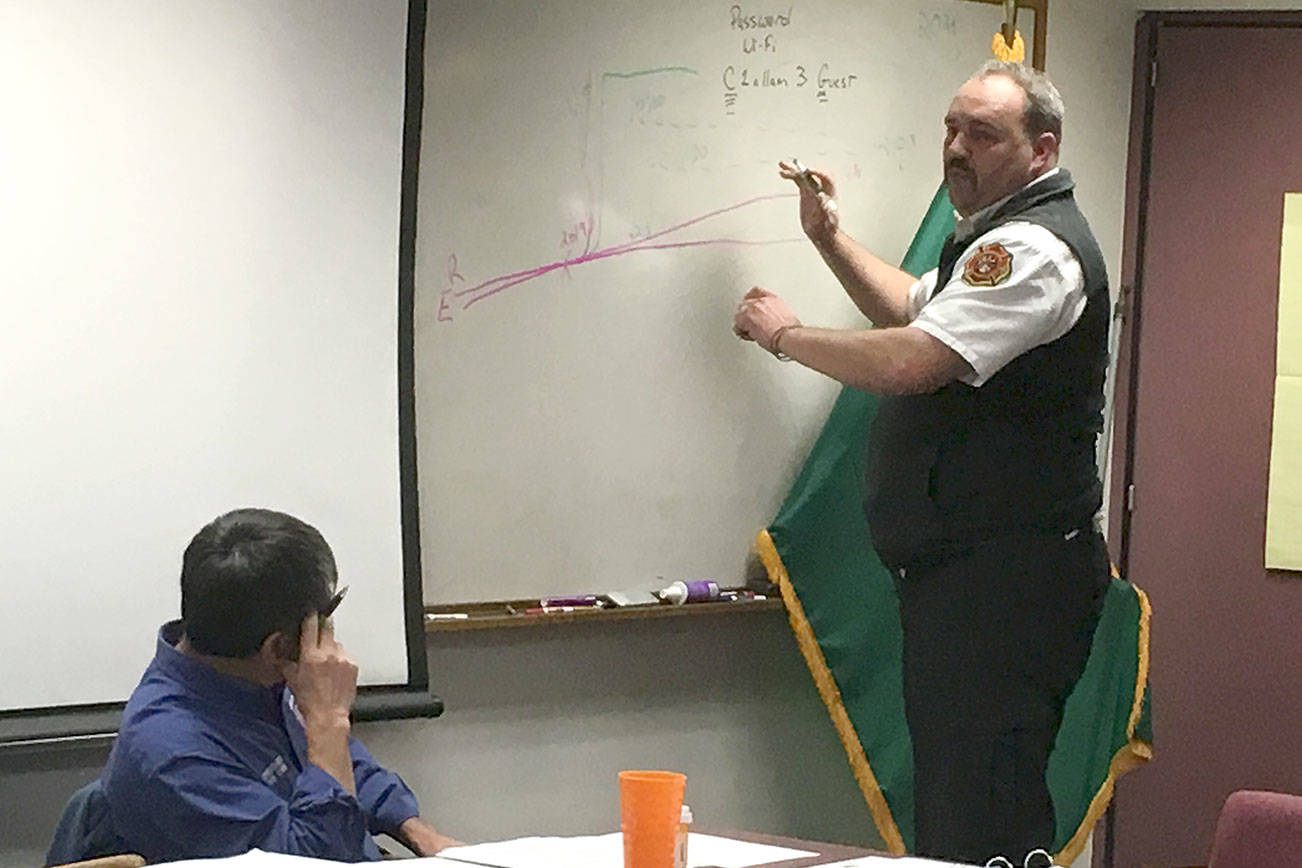SEQUIM — While Clallam County Fire District 3’s $9 million budget next year may be balanced, leaders within the department said they likely need the public’s help to keep from operating in a deficit in the years to come.
Fire commissioners told Fire Chief Ben Andrews they seek more information for a possible levy lid lift in November 2018 to put the Sequim-area fire district on more solid ground.
“We obviously need more funding and need to determine where that funding goes,” said fire Commissioner Mike Gawley.
“A lot of discussions are going to have to take place.”
Fire officials revealed the department likely will go into deficit spending in the third quarter of 2019 after investigating finances for a federal matching grant called SAFER, or Staffing for Adequate Fire and Emergency Response, that would have partially paid for six full-time firefighters over three years.
Fire commissioners opted not to accept the grant to avoid going into deficit spending sooner as it would have cost the district about $1.1 million over three years.
Andrews said the fire district has enough reserves to operate at current standards without any changes in staff bargaining or benefits through 2022.
If the district was to pursue a levy lid lift, Andrews said it would ask voters in the next general election to lift the levy rate from $1.257 per $1,000 assessed home value to a maximum of $1.50 to generate about $1.1 million of new additional revenue for the district.
He said a proposed levy increase would cost a resident with an assessed property of $250,000 about $60.75 per year.
One avenue the funding could support is more staffing, Andrews said, such as building funds to match the SAFER grant at a later date.
Options
Andrews said a levy lid lift could help in varying ways with staffing, building reserves and capital projects.
His biggest concern is addressing a growing demand at Station 34 on Fifth Avenue, he said.
In a recent study, the station was the district’s busiest, and overall the district has seen an increase in calls from 5,115 in 2008 to 7,336 in 2016.
At minimum, station 34 has four firefighters/EMTs working at a time but they are often split up. Andrews said adding a fifth person through a lid lift could provide a second medical unit.
To add even more positions and another unit, Andrews sees the SAFER grant as the best option to help with calls.
Sustaining the positions might lead the district to approach voters for an excess levy to support the new positions in 2022, Andrews said.
The district’s EMS levy of $0.50 per $1,000 assessed value of a property will be up for renewal in 2019 as well.
Levy cap
Before 2002 and when the 1 percent cap increase was passed under Initiative 747, Andrews said lid lifts and excess levies were less common and districts relied more on Emergency Medical Service levy renewals and the maximum levy lid cap.
“The new normal is we may need to go to voters more frequently,” he said. “We’ve been accustomed to moving forward and renewing an EMS levy.”
As the district approaches new levy options, Andrews said he believes voters want fire commissioners to be smart with money but also provide high quality services, not necessarily an abundance of reserves.
He told commissioners reserves aren’t an emergency replacement fund but to help during economic downturns, rainy day funds, unfunded mandates and for paying vacation to retiring employees.
To get a better grasp of the district’s finances, Andrews said fire staff will investigate in the coming weeks the district’s cash flow, reserve caps for comparable fire districts, rainy day funds and liabilities.
He estimates the district also having a long-term facilities, apparatus and equipment replacement plan by late spring, early summer.
Building a new fire station or buying fire trucks won’t be included in this plan, Andrews said, and those would likely require a separate bond if needed.
Fire staff anticipate the plan would call for about $300,000 a year.
To help form a plan for levies, the fire district contracted $13,500 this year and $45,000 next year with Liz Loomis Public Affairs.
For more information on Clallam County Fire District 3’s operations, call 360-683-3311, or visit https://ccfd3.org.
Budget
Fire commissioners approved the fire district’s $9 million budget for 2018 that includes funding 47 full- and part-time employees at about $6.2 million.
Capital expenditures next year include remounting an ambulance for $120,000, buying a new motor pool truck for $60,000, installing a new phone system for $30,000, and purchasing eight AED units funded by the Sequim Thrift Guild at $11,114.

